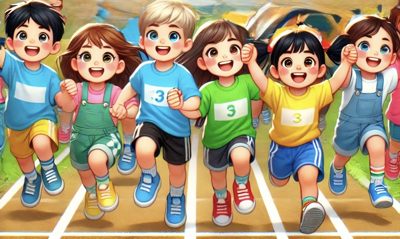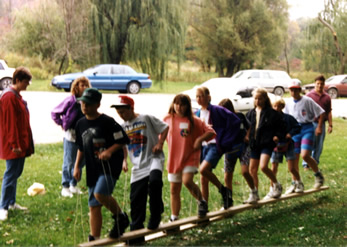Team Building - Collaboration
Team building, collaboration, cooperation, social skills

Google (2016) found, as a result of a massive investigation to find out how to build the perfect team, that psychological safety is the most important element for team work, increased productivity, creativity, and cooperation. See also cooperative learning and teaching.
Overview
- Introduction
- Background information
- Concepts
- Outcomes
- Focus questions
- Characteristics
- Effectiveness
- Rating sheet
- Proactive teams
- Suggestions
Introduction
This page includes team building activities to jump start cooperation and social skill development. It starts with background information to better understand team building and suggests ideas and strategies to successfully motivate teams to explore and develop both team building and social skills to support their abilities to build better teams. There are several activities, to choose from, wach with instructional suggestions to be able to use them with very little preparation.
Background information
Team building is an effort in which a team studies its own process of working together and acts to create a climate that encourages and values the contributions of team members. Their energies are directed toward problem solving, task effectiveness, and maximizing the use of all members' resources to achieve the team's purpose. Sound team building recognizes that it is not possible to fully separate one's performance from those of others.
Team building concepts
- Teams work together better if they communicate.
- Communication is between at least two people.
- Communication can help people learn.
- Practice can improve what you do.
Team building outcomes
- Teams will enjoy working together and achieving something they thought would be a difficult task.
- Teams will discover strategies of communication that will improve their ability to achieve.
- Teams will reinforce their learning how to learn.
- Teams will discover they can improve with practice.
Team building focus questions
- What does it mean to work as a team?
- Do you think that you can get better doing something if you practice?
Characteristics Of Good Team Building
- High level of interdependence among team members
- Team leader has good people skills and is committed to team approach
- Each team member is willing to contribute
- Team develops a relaxed climate for communication
- Team members develop a mutual trust
- Team and individuals are prepared to take risks
- Team is clear about goals and establishes targets
- Team member roles are defined
- Team members know how to examine team and individual errors without personal attacks
- Team has capacity to create new ideas
- Each team member knows he can influence the team agenda
Team Effectiveness
When evaluating how well team members are working together, the following statements can be used as a guide:
- Team goals are developed through a group process of team interaction and agreement in which each team member is willing to work toward achieving the goals.
- Participation is actively shown by all team members with roles being shared to facilitate the accomplishment of tasks and develop feelings of group togetherness.
- Feedback is asked for by members and freely given as a way of evaluating the team's performance and clarifying both feelings and interests of the team members.
- When feedback is given it is done with a desire to help the other person.
- Team decision-making involves a process that encourages active participation by all members.
- Leadership is distributed and shared among team members and individuals willingly contribute their resources as needed.
- Problem solving, discussing team issues, and critiquing team effectiveness are encouraged by all team members.
- Conflict is not suppressed.
- Team members are allowed to express negative feelings and confrontation within the team, which is managed and dealt with by team members.
- Dealing with and managing conflict is seen as a way to improve team performance.
- Team member resources, talents, skills, knowledge, and experiences are fully identified, recognized, and used whenever appropriate.
- Risk taking and creativity are encouraged.
- When mistakes are made, they are treated as a source of learning rather than reasons for punishment.
Rating Your Team
How do you feel about your team's progress? (Circle your rating).
1. Team's purpose
I'm uncertain of the purpose < - 1 2 3 4 5 - > I'm clear of the purpose
2. Team membership
I felt like a member < - 1 2 3 4 5 - > I didn't feel like a member
3. Communications
Little and not helpful < - 1 2 3 4 5 - > Very appropriate and helpful
4. Team goals
Set outside the team < - 1 2 3 4 5 - > Developed by the team's interaction
5. Use of team member's skills
Poor use < - 1 2 3 4 5 - > Good use
6. Support
Little help from all members < - 1 2 3 4 5 - > High level of support from all members
7. Conflict
Difficult issues are avoided < - 1 2 3 4 5 - > Problems were discussed openly and directly
8. Decisions were made
By few members < - 1 2 3 4 5 - > By all members
9. Risk taking
Was not encouraged or supported < - 1 2 3 4 5 - > Encouraged and supported
10. Effort to have positive relationships with all team members
Little effort < - 1 2 3 4 5 - > High level of effort
11. Distribution of leadership
One person dominated < - 1 2 3 4 5 - > Shared
12. Useful feedback
Very little < - 1 2 3 4 5 - > Considerable
The proactive approach manifests characteristics as:
- The team members take a very positive approach in jointly determining the way they are going to work together as a team and what they want to have happen. When individuals and the entire team choose to operate this way and are willing to set petty differences aside, unbelievable results become possible.
- When individuals adopt this attitude and commit to use their resources, knowledge, and skills to contribute to the goals of the team, alignment with the team's overall purpose comes about. This will not happen unless both the team leader and team members choose to do so.
- Having a well-defined purpose or vision of what the team will accomplish is a very powerful force for the team leader and members. Goals are aligned with the team purpose, and team members are empowered to accomplish the goals. This process leads to a high level of team productivity.
- Team members have a positive attitude toward change and are willing to accept and allow change to occur as needed in order to accomplish desired results.
- Team members understand that patience is required, and that for some goals, a long-term commitment is needed to accomplish the desired results.
- Interests of both the team leader and team members are focused on desired results rather than on short-term problem- solving activities.
- If people learn to focus simultaneously on both the current situation and the desired results, problems that arise will be solved as part of the total process of achieving the desired results.
- The members have a strong feeling of control within the team. They are able to establish priorities and then commit time and resources for accomplishing these tasks.
- Team members verbally and publicly support each other. They recognize that negative comments about others tear the team down.
- Team leaders and members that make a conscious, sustained effort to make these characteristics a part of their mind set will find that both creativity and accomplishment of desired results will be much higher than it would be otherwise.
Some Interesting Facts:
- When you’re in the middle of a problem, it’s sometimes difficult to see the solution.
- Everybody needs to be a part of the solution. Teams are interdependent.
- Everyone has their own perspective from where they stand.
Activity Team building suggestions
- Begin a discussion about what a team is.
- Tell the students that they will be doing an activity as a team that is challenging and will give them some ideas about team work and how teams can cooperate to achieve their goals.
- Present the challenge of board walking.
- Let the students try to walk from one point to another.
- After the students arrive at the designated point, discuss their team work.
- Share ideas with the team about what they did well, a handout, see background information, and ask for ideas to return to the starting position.
- When the team arrives at the beginning point ask them to evaluate their performance against whatever criteria or guidelines that were used.
- Determine if there are areas in which the team members could improve and accept suggestion for doing so.
- Continue until…
- I have observed teams that were able to literally jog on these boards. That’ team building.
Team building activities
Collaborative or Cooperative Race

Joe Greenberg Kappan. Spring 2025
Joe describes how he challenged a group of 20 kindergartners outside to a race where the only way to win was if everyone crossed the finish line simultaneously.
He says the first attempt was chaotic as some sprinted ahead and others lagged behind. When he rminded them that winning meant crossing togther, they looked puzzled. So he invited them to suggest strategies for achieving the goal. One student held hands with another and urged others to do so too. Soon the entire group ws connected and moving purposefully in unison crossing the finish line together. Their joy was satori!
How Many Squares? Puzzle. or Forty Squares Puzzle
Activity to use for team building, problem solving, spatial reasoning, mathematics, cooperative learning.

Five Squares
Learning, August/September 9, 1974. Break the Ice with 5 Squares by David Weitzman
Materials five envelopes with a mixture of puzzle pieces that when sorted will make five squares all the same size for each group of five people. Use the directions and square pattern sheets to print out instructions and five squares for each group of students, the linked file is formated to print each on a separate sheet of paper. Cut them out and put all the three A puzzle pieces in an envelope, all three B puzzle pieces in another envelope, and so on for all five pieces A-E. One envelope will be given to each person in a group of five. Instructional note: I have only used this activity with students age 10 through adult, therefore I changed rule 7 from its original form.
This is a giving game. You will be given an envelope with three puzzle pieces, do not open it until you are told to start. This is a group game activity and you will be competing with other groups against the clock.
I removed the hint: "This is a giving game." and the competition aspect. I thought removing the hint would make it more challenging and memorable. If students don't come up with the idea of giving or passing pieces, then it could be suggested if students seem stumped. I removed the competition reference as students will naturally want to be first and without it groups who don't finish first will hopefully continue to solve the puzzles with less frustration.
 Completed puzzles with labels for sorting into envelopes.
Completed puzzles with labels for sorting into envelopes.
Group Task
The group is to complete five solid white squares in such a way that each player has a square the same size as all the other members in your group. In other words, every group member has to end up with the same size square.
- The game must be played in complete silence.
- You may not point or signal other players with your hands or in any other way.
- You may not take a puzzle piece from another player.
- You may not place a puzzle piece next to another player's puzzle piece(s) to that they are using to try and construct a square.
- You may not fold a puzzle piece or overlap pieces to complete a square.
- When you have finished, cover your square with your envelope.
- This is a group activity, when all of you have an envelope, you may open them and begin.
Processing suggestions
- Ask, how they felt about not being able to talk?
- How did you communicate without talking?
- How did you feel about the group that finished first?
- How do you think the groups felt when groups were finished before them?
- How is working with a group different than working alone? Discuss both good and bad attributes.
- What did you learn about working with others? (Sometimes you have to give up your ideas so the group can all progress.)
Board Walking

Materials: two sixteen foot 2X4's, with 6 foot pieces of rope attached in loops every two feet on each board.
- Lay the boards parallel to each other with each loop on top.
- Have six students, one at each loop, put one foot on each 2X4, and hold the loop of rope from the right board in the right hand and the loop from the left in the left.
- Challenge tem members to walk forward in unison.
- See how fast they can go from one place to another.
- Can they go backwards? Sidewards? Left? Right?
Blanket Flip
Materials
- One blanket for each group of 5-10 students.
Object of the game: Flip the blanket over without any person stepping off of the blanket.
Have students in each group stand on the group's blanket and spread out across it. Challenge them to flip the blanket without stepping off of it.
Variation If they step off of the blanket they have to start over. See how fast they can do it.
Discuss how they fell about solving the problem. How they felt about practicing to develop a routine or getting better at it. Was it enjoyable, frustrating, ... other. Why?
Catch on and on
Materials
- One ball for each group
Rules:
- No talking or you are out.
- If you drop a catchable ball, then you are out.
- If you throw an uncatchable ball, then you are "out".
Object of the game: To see how long people can catch on and on or set a target (100 catches or other appropriate number).
Discuss how they fell about solving the problem. How they felt about practicing to develop a routine or getting better at it. Was it enjoyable, frustrating, ... other. Why?
Pretzels
Pretzels is a game described in Reality Therapy by William Glasser. It is also discussed in Teaching Children to Care: Management in the Responsive Classroom. by Ruth Sidney Charney. All students are given ten pretzel sticks. Go around the group and each person is allowed to make two statements: 1) a positive and give a pretzel and 2) a negative and take a pretzel. Other rules may need to be made to assure a learning environment. A different variation called center circle is also discussed in the Charney book. This involves students moving around the circle and shaking hands with a person or pounding their fist in the palm of their hand. When they finish students may ask why they thanked them or pounded them.
Hula-Hoop Race
Materials one Hula-Hoop for each team.
Have the teams line up in rows and hold hands. Put a Hula-Hoop on the ground at one end of each team. At the start command each team is to pass through the hoop without letting go of each other's hand.
Untangle
Materials none
Have a group of four or more students stand in a tight circle. Have them reach across the circle and clasp a person's hand. Challenge them to untangle themselves without letting go of each others hands. Vary the number of students to change the complexity of the solutions.